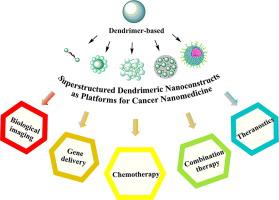Coordination Chemistry Reviews ( IF 20.6 ) Pub Date : 2020-07-06 , DOI: 10.1016/j.ccr.2020.213463 Cong Song , Mingwu Shen , João Rodrigues , Serge Mignani , Jean-Pierre Majoral , Xiangyang Shi

|
Poly(amidoamine) (PAMAM) dendrimers, as a family of synthetic macromolecules with highly branched interiors, abundant surface functional groups, and well-controlled architecture, have received immense scientific and technological interests for a range of biomedical applications, in particular cancer nanomedicine. However, due to the drawbacks of single-generation dendrimers with a quite small size (e.g., generation 5 (G5) PAMAM dendrimer has a size of 5.4 nm) such as limited drug loading capacity, restricted tumor passive targeting based on enhanced permeability and retention effect, and lack of versatility to render them with stimuli-responsiveness, superstructured dendrimeric nanoconstructs (SDNs) have been designed to break through these obstacles in their applications in cancer nanomedicine. Here, we review the recent advances related to the creation of SDNs such as dendrimer dumbbells, core–shell tecto dendrimers, dendrimer nanoclusters (NCs), dendrimer nanogels and dendrimer-templated hybrid NCs, and how these SDNs have been designed as nanoplatforms for different biomedical applications related to cancer nanomedicine including MR imaging, drug/gene delivery, combination therapy and theranostics. This review concisely describes the latest key developments in the field and also discusses the possible challenges and perspectives for translation applications.
中文翻译:

基于超结构聚(酰胺基胺)树状聚合物的纳米结构作为癌症纳米药物的平台:简明综述
聚(酰胺基胺)(PAMAM)树状大分子作为具有高度分支内部结构,丰富的表面官能团和受控结构的合成大分子家族,已在一系列生物医学应用(尤其是癌症纳米医学)中获得了巨大的科学技术兴趣。但是,由于单代树状聚合物的尺寸非常小(例如,第5代(G5)PAMAM树状聚合物的尺寸为5.4 nm)的缺点,例如载药量有限,基于增强的通透性和保留力的肿瘤被动靶向受限由于具有超强的树突状纳米结构(SDNs)的效果,并且缺乏使它们具有刺激反应性的多功能性,因此已被设计为突破这些障碍在癌症纳米医学中的应用。这里,我们回顾了与SDN的创建相关的最新进展,例如树状大分子哑铃,核壳结构树状树状大分子,树状大分子纳米团簇(NC),树状大分子纳米凝胶和树状大分子模板混合型NC,以及如何将这些SDN设计为用于不同生物医学应用的纳米平台与癌症纳米医学有关,包括MR成像,药物/基因递送,联合治疗和治疗学。这篇综述简要描述了该领域的最新关键发展,还讨论了翻译应用程序可能面临的挑战和前景。以及如何将这些SDN设计为纳米平台,用于与癌症纳米医学相关的不同生物医学应用,包括MR成像,药物/基因递送,联合治疗和治疗学。这篇综述简要描述了该领域的最新关键发展,还讨论了翻译应用程序可能面临的挑战和前景。以及如何将这些SDN设计为纳米平台,用于与癌症纳米医学相关的不同生物医学应用,包括MR成像,药物/基因递送,联合治疗和治疗学。这篇综述简要描述了该领域的最新关键发展,还讨论了翻译应用程序可能面临的挑战和前景。



























 京公网安备 11010802027423号
京公网安备 11010802027423号